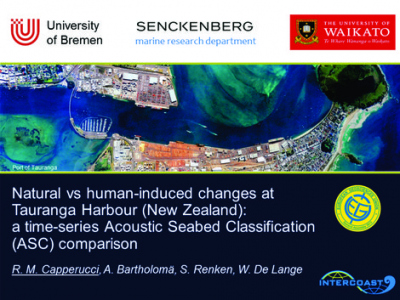Die Inhalte dieser Seite sind leider nicht auf Deutsch verfügbar.
Seitenpfad:
- INTERCOAST
- Latest News
- Archiv
- News 2013
- INTERCOAST PhD Student, Ruggero Capperucci, Attends EGU 2013 in Vienna, 7-12 April by Ruggero Capperucci
INTERCOAST PhD Student, Ruggero Capperucci, Attends EGU 2013 in Vienna, 7-12 April by Ruggero Capperucci
Vienna is like its most famous chocolate cake: simple, layered, rich, fine, extremely energetic, expensive, and… controversial. The Habsburgic center lies in the heart of Europe. It is a melting pot of Northern heritages and Southern culture. Its history is a wonderful synthesis of Roman golden age influences, French and Spanish marriages, north European trades, and relationships with the East European countries; its architecture a fusion of Christian inheritance and Oriental exchanges, of Baroque facades, and post-modern avant-garde.
With more than 11,000 participants, the European Geosciences Union General Assembly (EGU2013, 7-12 April 2013, Vienna, Austria) is by far the largest event for geoscientists in Europe. Established in 2004, this annual meeting has grown over the years to the current - impressive! - numbers, gathering scientists from all over the world in Vienna. The program of the conference covers a wide spectrum of topics, from structural geology to planet and earth science, from hazards’ forecasting and geoethics to specific upgrades for teachers and scientific communicators.
Special attention is given to young scientists (PhDs and young researchers) in the form of short courses (e.g., open access publishing), meetings with the “masters”, and introductions to editors and recruiters.
Within the session dedicated to “Coastal zone geomorphologic interactions: natural versus human induced driving factors”, I also gave a talk (Capperucci R.M. et al., 2013, Natural vs. human-induced changes at Tauranga Harbour (New Zealand): a time-series Acoustic Seabed Classification (ASC) comparison). The presentation was a review of the main results of research activity carried out during my stay at the University of Waikato (New Zealand) for the Intercoast project (IC5). The talk raised interest and questions between the audience, particularly regarding the implications for the debate about the environmental issues connected to the expansion of the Port and the application for its future development.
Being part of such a huge meeting was for me – at the same time – exciting and confusing. EGU represents the best way to keep (or get) in contact with edgy aspects of geoscientific research that rarely come out of the horizon of very specific journals. Finding a way to attend all the sessions I was interested in was a real challenge, including decoding the complex program and jumping from room to room. However, good inspiration can come from unexpected directions: so why not try?
With more than 11,000 participants, the European Geosciences Union General Assembly (EGU2013, 7-12 April 2013, Vienna, Austria) is by far the largest event for geoscientists in Europe. Established in 2004, this annual meeting has grown over the years to the current - impressive! - numbers, gathering scientists from all over the world in Vienna. The program of the conference covers a wide spectrum of topics, from structural geology to planet and earth science, from hazards’ forecasting and geoethics to specific upgrades for teachers and scientific communicators.
Special attention is given to young scientists (PhDs and young researchers) in the form of short courses (e.g., open access publishing), meetings with the “masters”, and introductions to editors and recruiters.
Within the session dedicated to “Coastal zone geomorphologic interactions: natural versus human induced driving factors”, I also gave a talk (Capperucci R.M. et al., 2013, Natural vs. human-induced changes at Tauranga Harbour (New Zealand): a time-series Acoustic Seabed Classification (ASC) comparison). The presentation was a review of the main results of research activity carried out during my stay at the University of Waikato (New Zealand) for the Intercoast project (IC5). The talk raised interest and questions between the audience, particularly regarding the implications for the debate about the environmental issues connected to the expansion of the Port and the application for its future development.
Being part of such a huge meeting was for me – at the same time – exciting and confusing. EGU represents the best way to keep (or get) in contact with edgy aspects of geoscientific research that rarely come out of the horizon of very specific journals. Finding a way to attend all the sessions I was interested in was a real challenge, including decoding the complex program and jumping from room to room. However, good inspiration can come from unexpected directions: so why not try?

Ruggero Capperucci at the entrance of the Vienna International Center, venue of the EGU 2013 conference.

Sachertorte, Vienna's world famous dessert.

Cover slide of the presented talk.


